Have you ever been hanging out at the park, heard a piercing whistle, and seen a dog-shaped blur go racing toward the sound?
Dogs who are trained using whistles can be an impressive sight!
Using a whistle can help your doggo hear and understand cues better, but you’ll have to teach her what the whistle means first — dogs do not automatically know what to do when they hear one.
Don’t worry! We’ll explain everything you need to know about whistle training below.
We’ll explain how whistle-training works, point out a couple of good whistles, and provide some step-by-step examples of how to incorporate a whistle into your training toolbox.
No time to read? Here’s what you need to know:
Key Takeaways: How Does Dog Whistle-Training Work?
- Whistles are great tools for communicating with your dog. Whistles not only work more effectively over long distances than your voice will, their consistent tones are helpful for training purposes too.
- Dog whistles aren’t magical devices. Your dog won’t automatically know know what to do when you blow the whistle — you’ll need to teach her what you expect her to do when you sound it in a given way.
- You can use audible or ultrasonic whistles — it doesn’t really matter. Ultrasonic (“silent”) dog whistles just operate at a higher frequency than normal ones do. We can’t hear them, but your doggo will hear them just fine.
- There are a bunch of great whistles on the market, but if you just want a quick recommendation, the SportDOG Roy Gonia Whistle is a great option for most dogs and owners.
How Dog Whistles Work: It’s Not Like You See in the Movies
When people train dogs to respond to a whistle, the four-footers learn that hearing the whistle is a cue to do something – it’s been paired with a behavior they already know how to do.
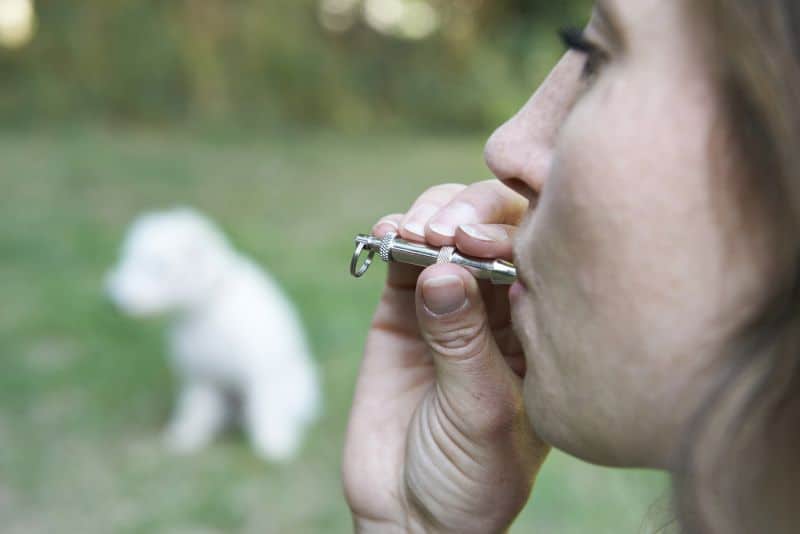
Just like when actors hear their cue lines and walk onstage right on time, dogs respond to the cues they’ve learned.
In other words, cues (such as the blast of a whistle) let dogs know when to do behaviors they’ve been taught.
But hearing a whistle does not innately mean anything to dogs, nor does it drive them crazy (though movies and cartoons might encourage audiences to think that is the case).
If your dog does not already understand or respond well to your verbal cues, using a whistle will not suddenly increase your dog’s rate of success.
However, if your dog’s recall isn’t as strong as you’d like it to be, the consistency of the whistle’s sound can help. Doing more recall training using a whistle and positive reinforcement is a great way to help your dog improve her overall recall response.
If your primary goal with a whistle is to improve your dog’s recall, make sure to watch our full video below on teaching your dog to come when called!
How Do “Silent” Dog Whistles Work?
“Silent” dog whistles are not magical communicators. In fact, to dogs, they aren’t silent at all! “Silent” or ultrasonic whistles simply emit sounds at frequencies most humans can’t hear.
Dogs can hear sounds of higher frequency than humans can. They also have hearing that is much more sensitive than ours is, even in the ranges humans can hear.
For instance, most adult people can hear sounds that range from about 20 Hertz (Hz) to 20,000 Hz. On the other hand, dogs can hear sounds from about 67 Hz to 45,000 Hz (“Hertz” is simply a unit of measure like feet or pounds that describes how high or low a sound is — lower numbers correspond with lower frequencies).
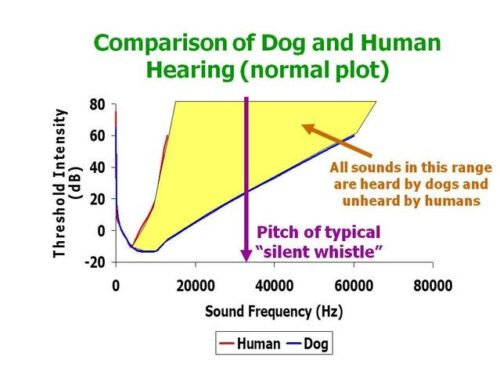
The sound of the typical ultrasonic dog whistle varies, but it is normally around 35,000 Hz, while audible whistles are usually in the 3,000 to 5,000 Hz range.
According to Stanley Coren, Ph.D in his book How Dogs Think, dogs can also detect tiny differences between frequencies. They can, for example, hear eight distinct frequencies between the tones of C and C#. That makes humans seem tone-deaf by comparison!
Dogs can also hear quieter sounds than humans are capable of hearing. For example, zero decibels (0 dB) is just barely audible to children, while dogs can hear sounds that get as quiet as -15 dB.
Dogs and people also have particular frequencies that their ears are especially sensitive to.
The greatest frequency sensitivity for humans is near 2,000 Hz, which is right around where human speech frequencies are. Dogs’ hearing is most sensitive at 8,000 Hz, which relates to frequencies of sound that a wild canine’s prey would make.
However, just like people, individual dogs have different hearing capabilities based on their breed and age.
For example, older dogs will often experience some hearing loss, though they may still be able to hear some higher frequency sounds.
Additionally, some breeds, coat colors, coat patterns, and ear shapes are known to correlate with deafness and hearing loss.
Do Dog Whistles Hurt a Dog’s Ears?
Whistles that are used for training dogs (including both ultrasonic and audible varieties) do not normally hurt a canine’s ears.
Again, there’s nothing magical about dog whistles — they’re just tools used to communicate with your canine.
But that doesn’t mean you should use them carelessly, either.

If you blow hard on a whistle when you’re close to your dog, it can be uncomfortably loud for her ears, just like it can for us if we’re sitting near a referee blowing the whistle at a sports game.
So, while whistles are great training tools for dogs, you should exercise common-sense and avoid blowing them loudly in close proximity to your pooch.
What Are the Benefits of Using a Dog Whistle?
Using a dog whistle to cue your dog can provide some noticeable benefits as far as successful training and consistency are concerned.
We’ll discuss a few of the most important benefits of whistle training below.
1. Whistles Are Loud and High-Pitched
Both audible and ultrasonic whistles are loud, so they are easier for your dog to hear if she is far away.
The sound of a whistle — even audible versions — is also high-pitched, which can make it easier for your dog to hear. This includes those times when you’re competing with excessive background noises.
2. Whistle Sounds Are Novel
The sound a whistle makes is not usually one that dogs hear in their everyday life. This makes it a novel, or out-of-the-ordinary, sound as far as your dog is concerned.
Because of that, many dogs show immediate interest in the sound of a whistle; they want to know what on earth made that sudden, unusual sound!
3. Whistles Make Consistent Sounds
Unlike your voice, which can sound different based on a variety of factors, whistles tend to make relatively consistent sounds. And since the whistle’s sound is consistent, your dog can recognize the frequency of her specific whistle easily.
This benefit of consistency is why many trainers prefer to use training clickers over reinforcing words like “yes” – the clicker always has the same sound and intonation, regardless of who is doing the training!
4. Whistles Don’t Lead to Desensitization
Your dog is unlikely to become desensitized to the sound of a whistle, unlike verbal cues, which often use words you say all the time.
When she hears her cue word but realizes she’s not being spoken to, nor is she expected to do anything, her response to the cue word can slowly get weaker.
This simply isn’t true for whistles, as she won’t hear them all the time.
5. Whistles Work Well with Multiple Trainers
Whistles help your dog take cues more easily from multiple handlers because she doesn’t have to generalize the whistle cue.
This means she shouldn’t have a problem understanding the same cue from someone else since the whistle sounds identical when used by different people.
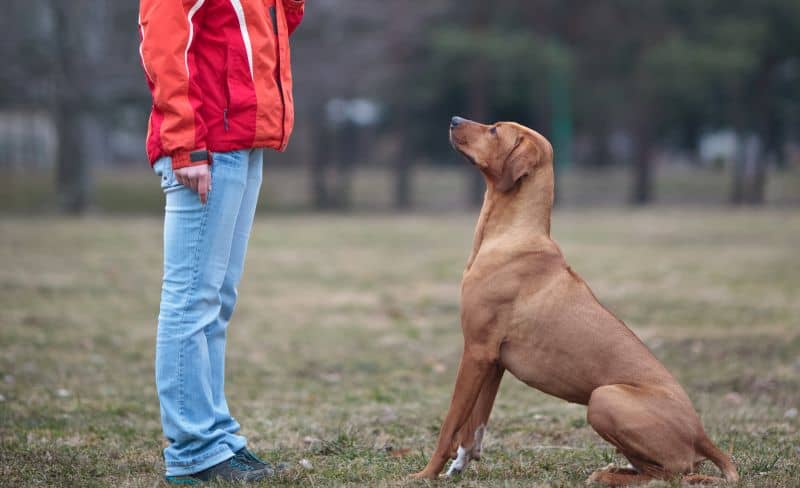
All of these things mean that when dogs are trained using a whistle, they will often have a more consistent response (they respond the same way each time they hear it) with lower latency (how long it takes for the dog to begin to do a trained behavior) than dogs that are given verbal cues.
These things are definitely related — because the whistle sounds the same each time, and your dog only hears it when being given a cue, she is much more likely to comply because her cue is “strong.”
This means that she is more likely to hear the cue once, and perform the behavior she’s been taught to do in response.
One final reason whistles can be useful is that your dog can hear them even if you can’t use a verbal cue.
I realized the need for a whistle in my training toolbox at one point when I was sick and lost my voice. I tried to call my dog during a walk, but he couldn’t hear me.
We started working on pairing a silent whistle to his recall cue that same week, and since my buddy got the best treats in the pantry during our whistle training, his recall to the whistle was even stronger than his regular verbal one!
Picking a Dog Whistle: Things to Think About
Whistles sold for dog training vary significantly. They differ in terms of size, what they’re made of, whether they’re “silent” or not, and if they have a “pea.”
All of these distinctions can determine if a particular whistle will be a good addition to your furry friend’s training regimen.
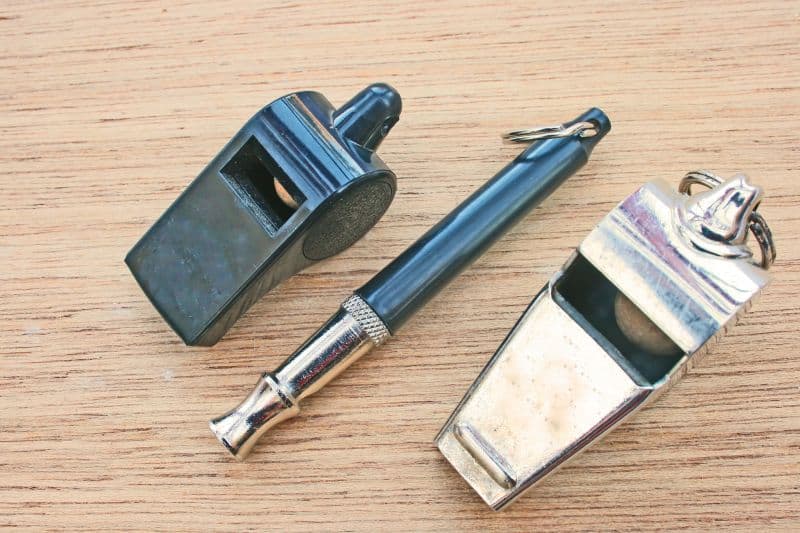
Here, we will go over the differences in available whistles so you can figure out which one is best for you and your pooch.
Do You Want a Silent or Audible Dog Whistle?
First, you’ll have to decide whether you want an ultrasonic whistle, or an audible one. Either type will work, but it’s a subject worth pondering.
Both types are loud, as far as your dog is concerned. But ultrasonic whistles are specifically credited with being easier than your voice for your dog to hear over long distances, even if you are shouting. So, if you’re planning on using the whistle over really long distances, you may want to go with an ultrasonic version.
Additionally, people who want to be able to cue their dog using a whistle in close proximity to other people tend to prefer this type so the people aren’t disturbed by you loudly using a whistle nearby. You could also use an ultrasonic whistle at night without fear of disturbing your neighbors.
On the other hand, the biggest benefit to using an audible whistle is that you can also hear it. You hear what your dog hears, so you’ll know exactly what your whistle-made cue sounds like.
Just try to decide whether you’d like to be able to hear the whistle, or if you’d prefer a whistle that’ll fly under the (human) radar.
What Material Should a Dog Whistle Be Made Of?
The material a dog whistle is made of and its durability are also important factors to consider.
Well-made whistles can save you a lot of extra work! If your whistle breaks, it’s possible that the next whistle you get won’t be the same frequency, which means you may have to retrain your dog using the new whistle.
Most dog whistles are made of metal or plastic. If you realize that a plastic whistle may not be tough enough to withstand your lifestyle or your dog (some dogs love their whistle, and may chew on it if they get the chance!), a metal whistle may be better for you.
Silent dog whistles have inner components that are made of metal, and they are often adjustable so you can find the frequency that your dog responds to the best.
However, if you will be taking your dog and her whistle to damp or muddy places and it’s possible that the whistle could get wet. Wet metal whistles may rust, but plastic whistles won’t, and they’re usually easier to clean.
If you want to know what frequency your whistle makes, there are free apps available for your phone that tell you the frequency of sample sounds.
This app lets you know the numerical frequency of the sounds it detects, which can let you know if one whistle sound matches another one precisely.
How Easy Is the Whistle to Carry and Store?
Because you’ll be using your dog whistle outdoors, it make sense to pick one that’s easy to carry around. This isn’t usually a big issue, as most dog whistles are small, and can easily fit inside a pocket or treat pouch.
However, some feature large horn-like projections or strange designs, which make them more difficult to tuck in a pocket.
But you may not want to have to repeatedly fish your whistle out of a pocket. Fortunately, some can also be attached to a carabiner or lanyard. This makes it even easier to keep track of your whistle and bring it with you wherever you go.
Just remember: If you don’t have your whistle with you, you can’t use it! So, try to pick one that comes with the kind of features that’ll make it easiest for you to keep handy.

To Pea or Not to Pea: A Trilling Question
Finally, what is a “pea,” and why would you want it?
A pea is a small ball, usually made of cork or plastic, that moves around inside audible whistles to make a trill sound, rather than the single-note tweet sound made by a pea-free whistle.
Some people think that the pea is useful for helping a dog hear the whistle sound better, while others seem to think that a pea-less whistle works more effectively.
One thing both camps can agree on is that using a whistle with a pea in very cold temperatures can cause the pea to freeze inside the whistle, which is not ideal since that would change the way the whistle sounds to the dog.
So, if you live in a cold climate, you may want to opt for a pea-less model.
But if you’re not in an area that experiences cold winters, either version should work well — just pick the one that seems most appealing to you and stick with it.
7 Best Dog Whistles for Training
Now that you understand the value whistles can provide and know a few of the things you should look for, we want to share a few of the best models on the market.
Just be sure to review each one carefully and select the model that best suits the needs of you and your dog.
1. SportDOG Roy Gonia Whistle
This is a sponsored placement, in which an advertiser pays a fee to be featured in this article. Learn more
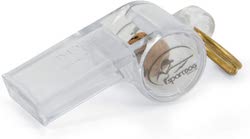
SportDOG Roy Gonia Whistle
Available in several versions
About: The Roy Gonia Dog Whistle is a premium dog-communication tool that comes in several different versions to suit your specific needs. Despite the differences between the models, each one is designed to be durable and easy to use.
According to the manufacturer, the Roy Gonia Whistle is used to train more field champions than any other whistle on the market.
Features:
- Comes with an attached metal ring for hanging on a lanyard (not included)
- Made in China
- SportDOG contributes time and funding to habitat-protection initiatives
- Weighs between 0.63 and 3.2 ounces, depending on model selected
- Produces audible tone humans CAN hear
Options: The SportDOG Roy Gonia Whistle comes in several versions: clear housing with a pea, orange housing with a pea, and orange housing without a pea. You can also opt for the Commander model, which is designed to work in inclement weather and comes with an attached mouthguard to provide a better grip.
PROS
Overall, most owners were quite pleased with the Roy Gonia Whistle. It seems to be very well-made, and most owners found that it was both loud and easy to blow. A few owners mentioned that it was even loud enough during high winds.
CONS
Although most such comments were rare, a handful of owners weren’t happy with the volume of the whistle. Also, it appears that the pea is made from cork, which means that it’ll get wet during use and stop working as effectively.
2. SportDOG Mega Competition Whistle
This is a sponsored placement, in which an advertiser pays a fee to be featured in this article. Learn more

SportDOG Mega Competition Whistle
Horn-style whistle for extra volume
About: Another whistle from SportDOG, the Mega Competition Whistle is designed for owners who want something with a few more — if you’ll pardon the expression — bells and whistles.
Its most notable feature is a horn-style housing that directs the sound forward. This not only helps protect your hearing, it projects the sound over longer distances than conventional whistles do.
Features:
- Large, horn-style housing projects the sound forward
- Features metal ring for hanging on a lanyard (not included)
- SportDOG contributes time and funding to habitat-protection initiatives
- Weighs only 1.6 ounces
- Produces audible tone humans CAN hear
Options: The Mega Competition Whistle is available in three different color combinations: black/clear, black/orange, clear/orange.
PROS
The majority of owners who tried this whistle felt that it lived up to its billing and worked fantastically. At least one owner found it effective at over 300 yards in high winds. The whistle’s design, which directs the sound forward and away from the user’s ears, also received a ton of praise.
CONS
Despite the glowing reviews most owners provided, some owners felt that the whistle didn’t seem especially loud. Additionally, some owners found the whistle to be bulky, and therefore hard to carry around.
3. Logan A1 Sheepdog Whistle
This is a sponsored placement, in which an advertiser pays a fee to be featured in this article. Learn more
About: The Logan A1 Sheepdog Whistle is perfect for owners who want a little more quality, durability, and “umph” than most plastic whistles provide.
Made from an anodized alloy and featuring a unique, ergonomic design, this whistle was designed by the UK’s seven time sheepdog-handling national champion and winner of BBC’s One Man & His Dog.
Features:
- Made in the UK
- Comes with carrying pouch to protect the whistle
- Instructions are included with your purchase
- Weighs 0.85 ounces
- Produces audible tone humans CAN hear
Options: The Logan A1 Sheepdog Whistle is available in your choice of seven colors.
PROS
Most owners who tried the Logan A1 raved about its performance. Phrases like “10/10” and “I’m in love” were common in user reviews. A few did mention a slight learning curve, but by and large, it appears extremely well-made, durable, and loud. Additionally, most owners found that the taste wasn’t objectionable (as is sometimes the case with metal whistles).
CONS
This is a pricey product. And while most owners were very pleased with the Logan A1 Sheepdog Whistle, a few were left disappointed and explained that it didn’t yield any obvious value over more affordable options. Some also explained that it feels small when held in the mouth.
4. KMNKSCN Dog Whistle
This is a sponsored placement, in which an advertiser pays a fee to be featured in this article. Learn more
About: The KMNKSCN Dog Whistle is a high-quality ultrasonic dog whistle that features a stainless-steel body. It is made with an adjustable screw and nut, which gives you the ability to fine-tune the whistle’s frequency and hone in on the ideal pitch for your dog.
Note that this whistle has a lower Amazon rating than most products we recommend to our readers.
However, this appears largely to be the result of improper marketing on the manufacturer’s part, which describes the whistle as being good for addressing nuisance barking.
We don’t doubt that it performs poorly in these applications, but it should still work very well for dog-training purposes, which is our focus here.
Features:
- Comes with a metal ring and a lanyard to make it easy to carry
- Weighs 0.63 ounces
- Allows you to adjust the frequency produced
- Produces ultrasonic tones that humans SHOULD NOT hear
Options: No options are available.
PROS
Despite the fact that many of those who purchased this whistle appear to have done so to address nuisance barking, those who used it for dog training reported good results. Additionally, the whistle was reportedly very lightweight and easy to use.
CONS
It doesn’t appear that many owners who purchased this for the correct purpose (dog training) were unhappy with their choice. As mentioned, it appears that the vast majority of complaints were from owners who thought this whistle would automatically stop nuisance barking.
5. FANZ Dog Whistles
This is a sponsored placement, in which an advertiser pays a fee to be featured in this article. Learn more
About: FANZ Dog Whistles are ultrasonic whistles that allow you to communicate with your dog without irritating your neighbors or the other owners at the dog park. This whistle features an adjustable nut and screw, which allows you to alter the frequency produced to achieve the best results. Note that this pack comes with two whistles and a clicker.
Features:
- Stainless steel mouthpiece and whistle body; ABS plastic cover
- Comes with a metal ring and an 18-inch lanyard for each of the two whistles
- Designed to be audible up to 25 meters away
- Each whistle weighs approximately 0.85 ounces
- Produces a user-adjustable range of ultrasonic frequencies humans SHOULD NOT hear
Options: There are no options available.
PROS
The fact that these whistles are sold as part of a two-pack means you get great value, and the included clicker only sweetens the deal further. The ability to adjust the pitch of the whistle provides great flexibility, and the included lanyards will help ensure you don’t lose the whistles.
CONS
A few owners complained that despite being advertised as an ultrasonic whistle, they could hear the tone readily.
6. ACME 211.5 Dog Whistle
This is a sponsored placement, in which an advertiser pays a fee to be featured in this article. Learn more
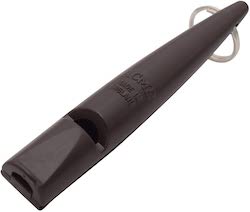
ACME 211.5 Dog Whistle
Simple, easy-to-use dog whistle
About: The ACME 211.5 Dog Whistle is a straight-forward, no-frills dog whistle designed to be lightweight, easy to use, and effective. This whistle produces a solid tone and does not include an internal pea.
Note that while the Amazon page for this product describes it as the 210.5 frequency model, the manufacturer explains that it is actually the 211.5 frequency model.
Features:
- Made in the UK
- Pealess design produces a solid tone
- Designed specifically for retrievers
- Features metal ring for hanging on a lanyard (not included)
- Produces audible tone humans CAN hear
- Weighs approximately 0.32 ounces
Options: The ACME 211.5 is available in your choice of 10 colors.
PROS
Most owners were pretty pleased with the ACME 211.5 Dog Whistle. It appears to work as advertised and get the job done, while being a fairly typical whistle that doesn’t include any unusual design features. Most owners found that it produced plenty of volume for their training needs.
CONS
The only common complaints seemed to be the result of owners who didn’t realize what they were buying — this is an audible whistle that humans can hear, rather than an ultrasonic whistle that’s only audible to dogs.
7. Fox 40 Classic Whistle
This is a sponsored placement, in which an advertiser pays a fee to be featured in this article. Learn more
About: The Fox 40 Classic Whistle is not specifically designed for dog training, but it’ll work well in such contexts. Made with a plastic housing and a fairly conventional, pealess design, this whistle is both loud and easy to use.
Features:
- Made in the USA
- Pealess, three-chambered design
- Paired sounding holes
- Features metal ring for hanging on a lanyard (not included)
- Weighs approximately 1 ounce
Options: The Fox 40 Classic Whistle is available in your choice of 10 colors.
PROS
Because this is a conventional whistle (rather than one marketed for dog owners), most of the reviewers were coaches, referees, and others who use whistles at work. Nevertheless, while specific experiences with dogs were rare, most people who bought this whistle found that it was durable, small (and therefore easy to carry), and quite loud.
CONS
Overall, this is a well-rated whistle, but as mentioned, it isn’t specifically designed for dog training. Other than that, the only common complaint about this model is that several users reported that it was too loud.
What Else Do You Need to Whistle Train Your Dog
Ready to begin whistle training your dog? Let’s make sure you’ve got everything you need:
- A whistle
- A treat pouch with a variety of small, high value treats
- A clicker, especially if your dog has been trained using a clicker already
- A long leash or two – safely practicing this new cue with more distance than ever before is a good idea!

Good Skills to Teach with a Dog Whistle
So, you’ve decided that whistle training is for you, and you’re looking forward to your well-trained, highly-responsive, whistle-receptive dog.
But, what do you want her to do when you whistle?
A whistle can be used to cue any behavior you want, and you can pair different whistle patterns or tones with as many different behaviors as you’d like. You’ll just need to be willing to put in the training time with your doggo to teach her what each whistle pattern means.
Watching a herding dog who has been whistle trained working a herd of sheep with their handler is an incredible display of communication and collaboration.
Working border collies usually know at least seven basic herding cues, all of which are communicated using various tones and patterns of whistles. This is necessary because those dogs are often moving livestock far away from their handler across large fields.
However, most pet dogs don’t need to know that many whistle-cued behaviors since they’re usually relatively close to their people.
Generally, owners who whistle train their pet teach their doggo different-sounding cues for one or more of the following behaviors:
- Come/Recall – The dog moves toward the handler and stops nearby. Typically, she is taught to stop close enough for the handler to touch.
- Sit or Down – The dog stops wherever she is and moves her body into a particular position. Often, she is also taught to stay there until she’s given a release cue. Teaching this behavior as a whistle cue is great for interrupting or pausing your dog at a distance. This can be really useful if, for example, she is chasing a ball toward a busy road.
- Attention – The dog turns toward the handler so she can get more information. This is usually followed by a body language cue given by the handler so she can continue moving in the correct direction.
Whistle-Training Your Dog to Recall (Come to You): A Step-by-Step Guide
So, now that you’ve got your whistle, your dog (who already has a reliable “come” recall cue under her furry belt), and your treats, let’s get started on adding a whistle-cued recall to your dog’s training vocabulary!
Just be sure to start simply.
Practice in your yard at home, using a long training leash if your dog may need it for safety, and keep your sessions short and successful.
With these things in mind, let’s get started!
- Step #1: When your dog is a little distance away from you (you can use a helper to hold your dog if you want), blow your whistle first, then say your dog’s known verbal recall cue (tweeet, “Come!”). Be sure that you always use the same sound length or pattern each time.
- Step #2: When your dog arrives next to you, click your clicker and give her an awesome treat. Repeat these steps about a dozen times, and end your training session on a good note (playing a favorite game or feeding a meal are great ways to finish a training session).
- Step #3: Continue to practice like this, adding distance gradually and safely, until your dog is doing a great job of returning every time you call her. Be sure to use all the distance you have available to you.
- Step #4: If your dog is doing well with these steps, start trying to gradually phase-out your verbal cue. Blow the whistle and then wait two seconds before saying your verbal recall cue. If she is already heading your way after just hearing the whistle, that means she’s beginning to understand her new whistle cue! Be ready to use your verbal cue as a backup if she ever gets confused about what the whistle means.
Remember to set your dog up for success! At this point, do not move out of sight of your dog, practice anywhere unfamiliar or near distractions, or use your whistle cue if you aren’t sure your dog will probably be successful.
Don’t only practice your recall after you’ve told your dog to “stay” somewhere.
You want your dog to be ready to head your way at any time, no matter what they’re doing.
So, be sure to “surprise” her with the recall command from time to time.
Remember to mark and reward your dog with a wonderful treat every time she gets it right for a while! Especially if your whistle-cued recall is going to be your “emergency” recall, you want your dog to be extremely excited about what will happen when she makes it back to you.
If your dog has figured out that the best things in life are in your hand when you blow her whistle, you will see her perk up instantly and she will hurry to return to your side!
A strong recall cue is worth every effort you put into training it, since a successful recall could save your dog’s life.
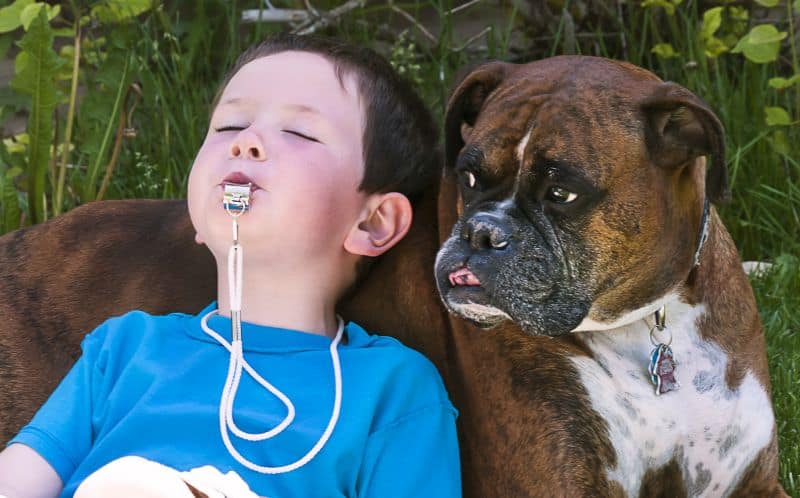
Additional Whistle-Cued Behaviors
What if you want to teach your dog another whistle-cued behavior? No problemo! Just use the same basic approach that you did for teaching her to come back to you in response to a whistle blast.
- First, make sure your dog knows the second behavior already and is good at doing it with just your verbal cue. For example, if you want to pair her “sit” cue with the whistle, make sure she’s already got that skill down pat.
- Then, decide on the new whistle pattern you want to use so your dog won’t get confused about what she’s supposed to do.
- At this point, you’ll want to use your new whistle cue followed by the second behavior’s verbal cue (tweet-tweet-tweet, “Sit!”).
- Mark (click your clicker) and reward her for successes, and continue doing short practice sessions in low-distraction locations until you can fade out your verbal cue a little.
Remember that if you’re using a whistle so you can add distance to your dog’s verbal cue, you will have more success if you add distance gradually as you continue to train.
If she ever has trouble or seems confused, set your practice sessions up to be a little easier (with less distance, distraction, or duration) and see if there’s a smaller increase of difficulty that can help her continue to succeed.
Dog Whistle FAQs
Whistle-training your dog can be a bit tricky at the outset. This causes many owners to have questions about the process.
We’ll do our best to answer some of the most common dog whistle-training questions owners have below!
How are dog whistles silent for people?
Dogs can hear frequencies higher than humans can, and “silent” dog whistles are actually just at higher frequencies than most people can hear. However, some people (particularly young people) can still hear “silent” dog whistles!
Do dog whistles hurt a dog’s ears?
Dog whistles do not hurt dog’s ears unless someone blows the whistle very loudly when they’re close to a dog. If a sports whistle is blown hard close to our ears, it’s uncomfortable for us to listen to as well!
Are all dog whistles silent?
Some whistles sold to train dogs are ultrasonic, and some are audible to people as well. The correct type of whistle to use when training your dog depends on the situations in which you plan to use the whistle.
How effective are dog whistles?
Dog whistles are only as effective as the training that the dog receives. If your dog does not know how to do a behavior well, using a whistle will not automatically teach her to be more successful.
However, using whistle training to help dogs hear their cues over long distances is quite effective, once they know what they’re supposed to do when they hear the whistle.
Can you use a dog whistle to stop nuisance barking?
Dogs bark for many reasons, and quite a few products have appeared in recent years that use ultrasonic noises to distract dogs who bark at everything.
None of them are guaranteed to work for any specific dog, and they do not actually train the barking dog to do anything different, they often just distract the dog which interrupts or startles them for a short time.
If the dog ignores or gets used to hearing the ultrasonic sound made by a machine or a dog whistle, they will not stop barking when they hear it. Pairing the dog’s silence which may occur after an ultrasonic sound with rewards may help her learn that her quiet is worth the effort!
How does a dog whistle work?
A whistle-trained dog understands that when she hears a whistle, she is supposed to do something specific.
In order for her to understand this, she needs to have some training during which the whistle is paired with her known cue for that behavior.
Once the dog understands that hearing the whistle means she’s supposed to do only that one behavior, and she does it consistently when she hears the whistle, she is said to be whistle-trained.
When can you start whistle training?
You can start teaching your dog with a whistle as soon as they can consistently perform any behavior you’d like to be whistle-trained using a verbal cue.
If your dog is deaf or hearing-impaired, using a tactile trainer like a vibration collar will get you much better results!
***
Have you ever wanted your dog to respond to a whistle? What sorts of things would be the most useful for her to do, even if she’s far away from you? What useful things does your dog do when you whistle?
Share your experiences (and any questions you may have) in the comments below!










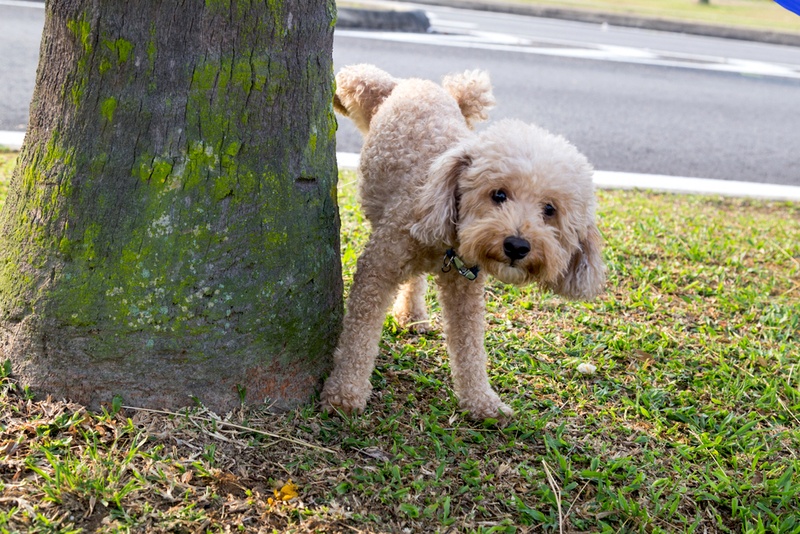

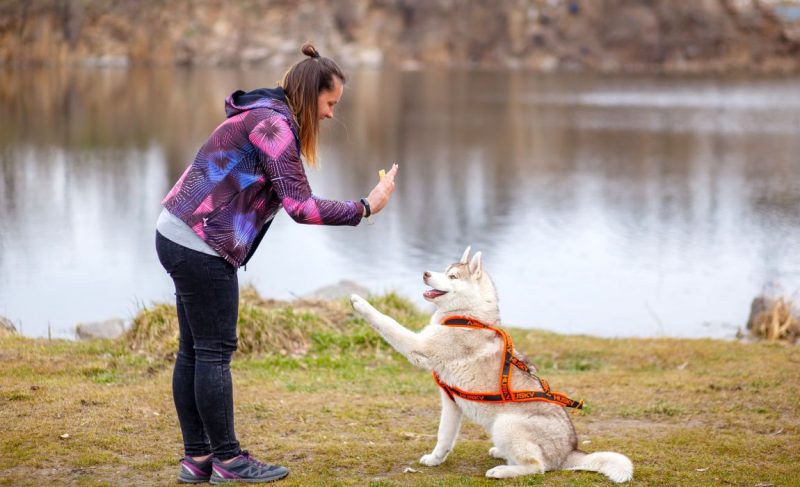
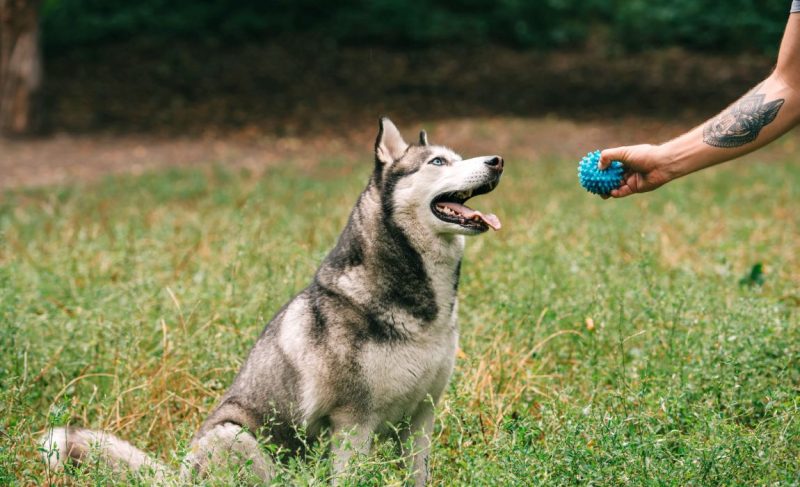
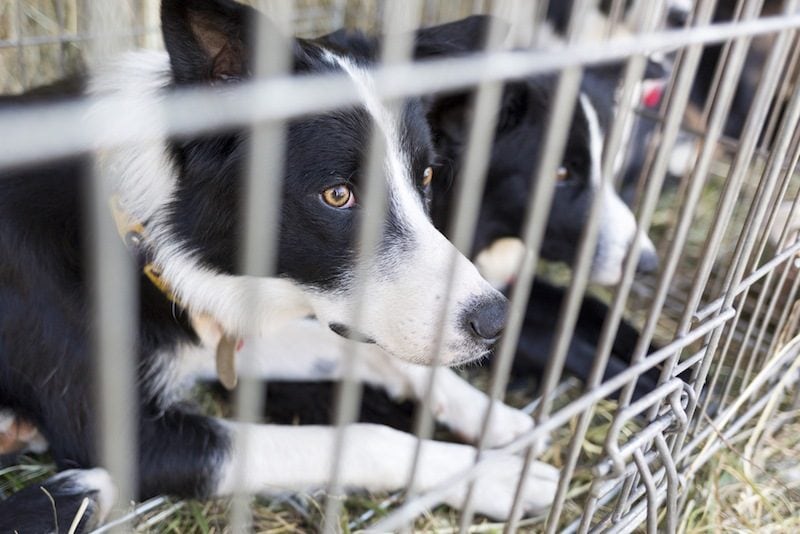


Leave a Comment